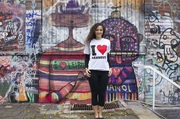Prague is one of the most historic European capital cities. This medieval city flourishes with Gothic, Romanesque and Baroque era architecture alongside with secretive, narrow pathways that meander to remote courtyards and off-the-beaten-path streets.
Those who visit Prague are rarely disappointed. Between architectural beauties and fairy tale-like streets, these are some of the best historic sites to see and visit while in Prague.
There's more to Prague than what meets the eye. In "recent" history, 1988 to be exact, the Lennon Wall served as a source of irritation to the communist party. Young Czechs wrote grieving messages on the wall, all the way to the Charles Bridge. This led to a clash between the police and protestors. The movement was described as "Lennonism" Communism banned western pop songs, but specifically, The Beatles as Lennon's lyrics praised freedom, something that did not exist in the East. Today, the wall continues to change, mainly with Beatle quotes, images and logos. Look for the wall in Mala Strana, near the French Embassy.
The 15th Century astronomical clock, and the precession of the Twelve Apostles, is one of the most popular spots in Prague. On the hour, when the clock strikes, Christ marches out, followed by the 12 Apostles and a defiant Turk. The hall was built in 1338 and in 1865, Josef Manes added the 12 medallions alongside with the 12 zodiac signs. There are three circles on the dial that shows different times such as the the outer circle with Schwabacher numerals for the Old Czech Time, the circle with Roman numbers signifies the Central European Time and the inner circle with Arabic numerals for “Babylonian Time.” The little star signifies the sidereal time.
Do you want to know what life was like hundreds of years ago? If so, visit Golden Lane (Zlata Ulicka) in the complex of Prague Castle to see doorways that stand at the height of your chest. Constructed in the 15th Century, only 14 houses remained after 1657. Legend has it that Golden Lane got its name from the alchemists who lived on the street during Rudolf II's reign who "turned metal into gold." After an explosion, Uhle was found dead with a yellow stone in his hand (gold). To this date, no one knows how he got gold into his home. Notable historic residents include writer, Franz Kafka (house 22) and Prague Prophetess, Madame de Thebes. Unfortunately, the gestapo killed Madame as she predicted the end of the Nazism.
Charles Bridge
This stunning old bridge is a place where artists and artistry unite. From handmade necklaces to cityscape paintings, the Charles Bridge is the perfect spot for a romantic walk or an affordable art piece. Busy at all times of day, this bridge crosses the Vltava River and connects Old Town to Lesser Town. In 1357, The Roman Emperor and Czech King Charles IV commissioned the bridge. It is said that the constructor, Petr Parler mixed egg yolks in the mortar to strengthen its consistency. Baroque statues tower alongside the edges. These are duplicates and many originals are in the Lapidarium. The bridge is a must-see at night. Nothing beats the "eeriness" than fog accompanied by a full moon.
"Busy but beautiful," claims many tourists. The square is adjacent to the Astronomical Clock. While blinded by bustling cafes, keep your head down to notice "X" marks on the ground. This signifies the "place of death" where many witches were hung during the Witch Trial era. Cafes here are pricier, but are well-worth it for the atmosphere.
When you look at Prague's skyline, this cathedral towers the skyline. Charles Iv commissioned construction in 1344 over top the 10th Century rotunda. It took near six centuries to complete and most consider this cathedral the most important building in Prague. Entry is free, but the tour is an additional fee. You can also purchase a castle tour and Prague Historic Building Ticket Bundle.
Located in Old Town, Tyn was founded in 1385 as the Old Town's main church. The high-Gothic exterior contains twin towers, but boasts a Baroque interior. This church certainly has it's own book of history. A fire caused damaged in 1679, resulted in the Baroque redesign, but luckily it did not harm the 1673 organ that still stands today (and the oldest organ in Prague). If you look closely, the Towers are not symmetrical. One tower, Adam, is larger than the other, Eve. Today, the church hosts Roman Catholic ceremonies.
Vinarna Certovka
This is the most narrow passageway in Prague. It's so narrow, the city installed a streetlight. The width measures 19.6 inches and is an Instagram-worthy location. Be sure to hold in your gut!
What's your favorite site or landmark in Prague?
This Lemon Tree article is now featured on GPSmyCity. To download this article for offline reading or travel directions to the attractions highlighted in this article, go to 8 Historical Sites You Must See in Prague. .
Let's Connect!









 RSS Feed
RSS Feed